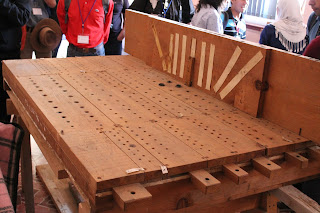Visiting Oaxaca is like waking up in paradise. But what is Paradise without a nice welcome and a delicious meal.
When our group made its early afternoon caravan out of Oaxaca, heading east, we arrived to nearby Huayapam, in the Central Valleys, and we were immediately greeted by a local welcome committee, who offered us refreshments in the courtyard on the outside of the Church of San Andrés, not served in cups or glasses, but in jicaras or terra cotta bowls, much the same way as Dominican Missionaries were greeted here almost 500 years ago by the Zapoteco tribesmen and women.

Estela drinking tejate from her
jicara.
jicara.
After our initial non-alcoholic welcome "cocktail", we were served an early afternoon dinner, featuring the local popular "mole". A "mole"is a dish that combines several different chiles, nuts and sometimes chocolate. In Huayapam, the specialty is "mole Amarillo" or yellow mole, with beef shanks and chayotes, a vegetable commonly used in Mexican cuisine, but much lighter and full of water.
Mole Amarillo is delicious, but to some palates accustomed to more day-to-day cuisine, it may result in a taste which is slightly course. In Mexico City, in our finer shopping and commercial districts, we can find a variety of "moles": "mole poblano", "mole oaxaqueño", "mole acacahuatada", "mole almendrado", which are tamed down to become more palatable to our everyday taste. However the wonderful experience that the organizers of IOHIO (Instituto de Organos Historicos de Oaxaca) was that they gave us the experience of authentic native food, the food that the people of Oaxaca have been cooking for centuries. And we had the opportunity to wash it all down with a plentiful supply of locally distilled mezcal,
Mole Amarillo.
The Church of San Andrés Huayapam was built in the late 16th century, while the organ was built in 1772, as we can inscribed on the central façade pipe.
The façade of San Andres Huayapam with twin
bell towers but without stone-carved figures
of saints.
The organ here has laid silenced for over a half of a century (last used during the decade of the 1960's). It is a 4' table organ, which once was located in the choir loft, but now is located on a side chapel off to the right side of the main altar. The tonal base is provided by a 4' principal, and the pitch reaches up to 392 Hz. But if the case is visibly smaller than 4'! The largest pipes are 4' (122 centimeters),but they are bent in order to fit.
View of the 4' tabletop organ from the rear.
The table organ of Huayapam has certain peculiarities that make it very different the organ we saw that morning at Jalatlaco. The most notable difference is the keyboard with only 45 notes C to c'''. Now is that 4 octaves? A standard octave has 7 natural notes, and 5 sharps, thus 12 notes. So if a keyboard starts with a C (two octaves bellow middle C) and ends with a c''' (which is two octaves above middle C), some keys or notes are missing apparently on the keyboard. 4 octaves x 12 notes in each octaves, plus the final c''' should make 49 notes or keys, and not 45. On the keyboard, the naturals are made of cedar while the sharps were made of walnut.
The keyboard of the organ of
Huayapam has a short octave
on the far left.
Organ builders in Oaxaca during the 17th and 18th recurred to something similar to a musical shorthand, creating the short octave, where most of the sharps are eliminated in the last and most base octave, as most of the music composed before Bach did not require them. If you take a close look at the bass or left end of the keyboard in the above picture, it apparently doesn't end in the C, but in E.
The case of the 4' table organ of Huayapam is made of ayacahuite, and was repainted maroon sometime in the last 100 years, while in certain corners of the keyboard and the moldings we can see a previous color which was a bright red. The frontal pipes are arranged in a 7-5-7 array. The pipes are covered at the top with wooden carved floral shades.
The top of the front case of the organ of
San Andrés Huayapam
At the top of the case, there is a chalice at the crest. The case is 150 centimeters (60") high, 112 centimeters wide, and 65 centimeters deep. Including the table, the total height is 225 centimeters (7', 4").
If you take a close look at the tubes in the above
picture, notice that the tubes in the right are
wooden and the lowest notes on the principal.
The pipes that we see today in the organ are probably all the originals. Four of the most base tubes are wood, while all the rest are metal, of a very soft alloy. Four of the largest pipes in façade section are bent, because they are too long: one central, two on the RH (right hand) and one on the LF (left hand). It is feasible that this organ was originally built as a 2' organ and then later modified to 4'.
The bellows of the Huayapam organ
There are two wedge bellows on the table behind the organ. The bellows are 48 centimeters (19") wide, 107 centimeters (42") long. Seven folds in the bellows. The weights are made of lead.
Lead weights of the bellows.
The fresco of Saint Christopher on
the side wall of the Church.
Principle nave of the church of
San Andrés Huayapam
Side chapel of San Andrés Huayapam
The church of San Andrés Huayapam has in its side chapel a collection tures, we can of "ex-voto" paintings, which claim miraculous intervention as a response to a persons needs and their prayers or prayers of their families. In the following pictures are some of these "ex votos":



















































